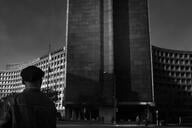You have /5 articles left.
Sign up for a free account or log in.
Once in a while a story comes along that weaves interfaith dynamics across time and space, weaving art forms and opening our eyes to the remarkable dimensions of what – at first glance – seems ordinary.
Take the blues as musical wail, an expression of unbearable mourning, juiced alchemically into cathartic expiation. Arguably the last standing giant of the genre, Buddy Guy, puts it this way: “Funny thing about the blues—you play ’em ’cause you got ’em. But, when you play ’em, you lose ’em.” (see the excellent New Yorker profile on Guy from earlier this year). Guy, son of the Great Northward Migration, Chicago legend, octogenarian guitar virtuoso of sheer lightning electricity, is going strong; but when he finally goes, the sun will set on his generation.
As for interfaith dynamics, it turns out the story of blues is layered with complex intersections of religious diversity. The form grows out of the gospel tradition, and both vocally and in its recognizable guitar intonations like the prolonged note bend, also has Muslim roots. About half of the African Americas sold into slavery in the United States came from Muslim majority regions of Africa. They came with sounds of the adhan – the call to prayer – in their bones. The adhan, with its malismas (a single syllable stretched through different notes) and communally binding character, helped to shape the field holler, or slave song. Have a listen: here’s a sample from the late great archivist Alan Lomax.
From adhan, to field holler, to the Great Northward Migration and the flourishing of American blues, to Buddy Guy’s Chicago – life is more complexly beautiful and interconnected than meets the eye. This terrain was covered recently in the opening of a suburban Chicago play, American Griot. A fantastic piece covering the play by Ronnie Malley and Reginald Edmund appeared in Religion News Service . Follow Johnson’s classic with a listen to this adhan, and you might be paraphrasing Proust: true listening is not in seeking new sounds but tuning in with new ears, hearing the layers of influences that have created the singular, beheld piece.
As for interfaith dynamics moving across space, let's turn to what is surely one of the most poignant expressions of the tradition, and one of the greatest recordings ever captured. Replete with malismas and bends that betray the connections between adhan-field holler-gospel-blues, is Blind Willie Johnson’s Dark Was the Night, Cold Was the Ground, here. Johnson modeled Dark Was the Night on the Christian hymn, Gethsamane. Ry Cooder praised it as “the most transcendent piece in all American music.” So transcendent that Carl Sagan included it among the most sublime sounds humanity has produced on a record bound for interstellar travels on the Voyager 1 spacecraft (here), now somewhere on the outer fringes of our solar system.
On the 50th anniversary of the moon landing, I was enriched by reading of a few diverse expressions of religiosity in space. Buzz Aldrin received communion before his moon walk 50 years ago; Israeli astronaut Ilan Ramon, recited Kiddush on the sabbath aboard the Space Shuttle Columbia, and Muszaphar Shukor, a Malaysian Muslim astronaut, received a government-backed fatwa allowing him to pray simply facing Earth since it was too complicated to pray toward Mecca while orbiting at 17,500 MPH on the International Space Station. Blind Willie Johnson, seamlessly weaving the field holler and the adhan into the blues built on a Christian hymn is the only interfaith expression I am aware of, safely etched on to a golden record, hurling across space.

